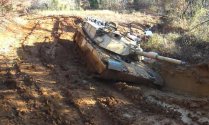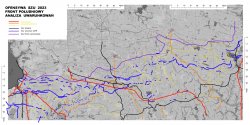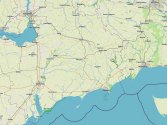Feels a little off top ic, but frankly I think it’s pretty damning of how major militaries have taken their eyes off the ball when it comes to de-mining work that no one has developed and fielded an air deployable mine clearing line charge (MCLC).
It can’t be some insurmountable engineering challenge to integrate a MCLC with a flying munitions dispenser so you basically fly a number of those over a minefield and they just deploy enough MCLCs to punch a path through a minefield so your mechanised units can race through at full speed instead of crawling along at the speed of the ABV. If timed well, the massive dust cloud from the MCLC detonations might also serve as an effective smokescreen for the attackers.
This is the sort of thing you would expect a bunch of engineering undergrads to be able to mock up as their final year project since all the major components are basically off-the-shelf items.
You decided to post an off-topic rant in which you dismissed an entire field of military engineering that armies all over the world develop as part of their routine operations as well as all the military-technical universities which have actual "
bunches of undergrads" working on specific military-focused problems in said field as part of their education.
Anyway...
Crossing an area at full speed if it hasn't been properly recce'd is extremely risky. The reason being that ground structure isn't identical everywhere and either on its own or due to several 60t tanks going at 40km/h disturbing the ground structure it can collapse in places leading to this:

There problem here is that there's no way to tell if the ground can support a tank unless you drive a tank over it. Sometimes it does, sometimes it doesn't and sometimes it does but you slide down and it doesn't anymore. One really needs to see a tank platoon or company during exercise to understand the challenges because they're far from obvious. The common sense on what tanks can and can't do is very wrong because unlike civilian vehicles which move over hard surfaces designed specifically for vehicle movement tanks move over unprepared surfaces. Driving a tank is more like walking across a river. Roads are built to be driven on in controlled manner. Tanks go where maneuver is tactically advantageous meaning you drive the tanks where the enemy doesn't expect you to drive it.
There's an entire sub-field of military engineering called "getting tanks across". That's how much of a challenge it is to move such mass from A to B.
Also contrary to wheeled vehicles tanks have excellent braking on hard surfaces due to large friction area of their tracks but they can be at a disadvantage when moving through soft ground. While wheeled vehicles get stuck in mud due to point pressure, tanks can get locked in a slide where the driver loses control of the vehicle. And then they can get stuck.
The "
massive dust cloud from the MCLC detonations" is the condition that any tank driver wants to avoid as it may easily lead to driving off the cleared path. Good practice also requires that the cleared path is at least visually assessed before proceeding forward.
The way the line charge works is that it creates a uniform shockwave front that detonates the mines through pressure and clears the mines that are not detonated off the blast area. For that the charge has to be continuous and as uniform as possible because mines are designed to be triggered by very specific conditions and hardened against blast damage. You can't clear it by multiple dispersed charges because then the shockwave front will not be uniform and may cause some of the undetonated mines to fall within the cleared path. It only takes a single mine to halt an entire column and if the mine is dropped somewhere in the middle of the cleared path it may detonate under one of the following tanks blocking the ones in the front from retreating.
The pressure necessary to achieve that is significant and the design of line charges is optimal at around ~6-7kg per metre which at approximately 100m length of charge gives 600-700kg plus the launching rocket. The charges are designed in such manner so as to ensure that they will fall on target area in as predictable and controlled manner as possible. Because of how resistant to blast mines are even 1-2m off target can put a live mine in the path of a tank during the crossing.
The cleared path needs to also be straight so as to not force the driver to make random turns, especially as tanks moving over soft ground will disrupt it further making it difficult to tell apart where the safe area is and where it isn't. And in general driving a tank isn't nearly as easy as people think it is. And a live mine may be just next to your track.
Finally the reason why breaching operations are so difficult is because they are the mechanised equivalent of tightrope walking which is performed by an entire unit at the same time while under fire which usually results in being effectively blinded
and all of it has to happen within as short a span of time as possible because as soon as the breaching operation is detected the area will be covered by artillery fire and then by cluster munitions with anti-tank mines to prevent recovery.
Dropping a line charge from aircraft has all kinds of limitations the obvious one being that it's a large object - constrained more by volume than mass - that needs to come in at least 50m sections. Then the placement of the charges must be
precise and that is very difficult for a fast-moving aircraft dropping an object which will be affected by not insignificant degree of air resistance and all other forces. And you can't drop it from low altitude because if the mines go off they may damage the aircraft.Any aircraft that isn't moving fast and is capable of lifting the charge is too expensive to risk shootdown.
------------
I wanted to post a map that a made over the weekend - a map of major roads between the front line and the main Russian line of defense in the Zaporozhia. The image is large - 4600x2300 pixels - but it shows the main constraints of maneuver and logistics.
The roads are as shown on OpenStreetMap at scale "12":
- orange - "yellow" roads on OSM@12, all with numbers,
- yellow - "wide white" local roads on OSM@12 , some of which have numbers
- red - major national roads/highways
- black - railways, paired with "wide white" class roads
- purple - front line
- blue - russian defensive lines as indicated by satellite imagery
- darker lines on greyscale background - field roads and minor gravel roads.

Note the scales around the map.
I've made a similar analysis last year w/r to Kherson but i can't remember if I posted it here. It was based on what i know of tactics and all the engineering and logistical factors and the actual movements of both Russian and Ukrainian forces essentially matched my predictions so i thought I will share it so that some of you - at least those who are interested in study of military operations - can use it as learning aid. It's not perfect but I do recommend you give it a look as remembering this particular network of roads and railways is very useful for contextualising movements of both sides. I did not include smaller roads because as Kherson proved they are not treated as major arteries. I actually thought that roads one category lower would still be prioritised but Russian forces treated them no different than movement across field. Those I put in colour were treated as major lines of communication and maneuver was conducted along them. If it feels wrong because there are gaps on the map - that's not an error. That's the actual road density there.
Also another interesting observation - but one that i didn't indicate on the map - is that when you connect the red dots north of the frontline, which are locations of Russian arty strikes on 11/6/23 then the approximate 20km and 35km ranges for 122mm and 152mm artillery fall
exactly along the main road networks. This means that Russian artillery is using those roads for supply and maneuver and that will have major consequences if AFU manages to close in to the main line of defenses (blue) because then Russian artillery will have to retreat to stay out of range of Ukrainian light artillery (105/122mm and 120mm mortars) and that will mean moving it off the roads that enable fast movement.

The area between the main line of defense and the coastal M14 highway is even less well developed than in the north.
This is very serious because it indicates that Russia has no depth for defensive maneuver because of lack of roads. That in turn means that once the fighting reaches this main line of defense in blue we will see fighting on the scale that is comparable to the Russian spring offensive/phase 2 in 2022 i.e. Lysychansk/Severodonetsk. AFU has to break it to collapse the front and Russia must hold it and once AFU gets in range the casualties will equalise. It will be brutal.
First warning: stop insulting people regardless of how they view things


